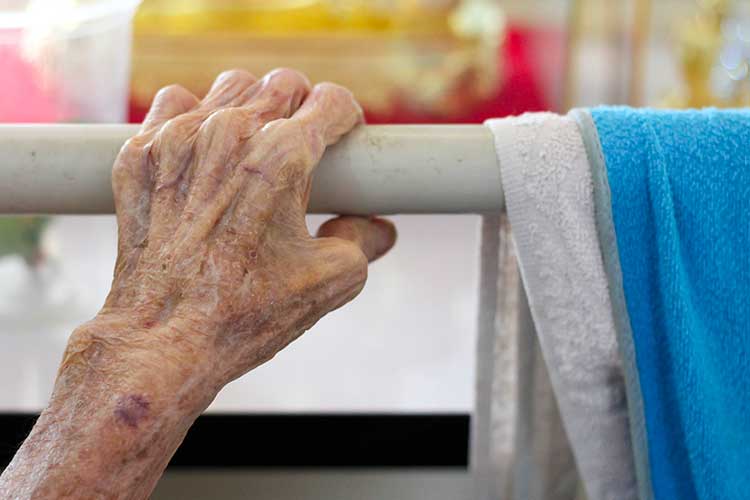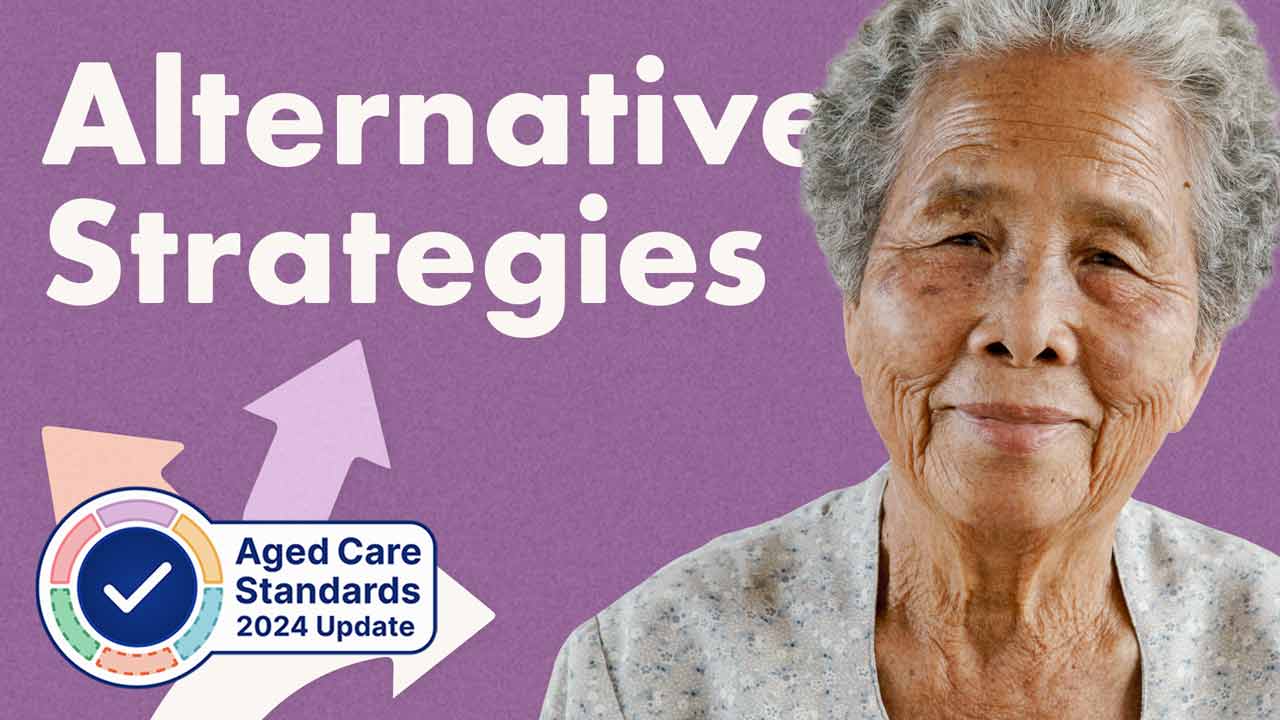This article is intended to be read alongside Minimising Restrictive Practices in Aged Care: Rules and Regulations.
In aged care settings, restrictive practices have been cited as a means of managing changed behaviours (including behavioural and psychological symptoms of dementia) and preventing falls (RCACQS 2019).
In reality, restrictive practices are linked to a variety of adverse care outcomes ranging from injury to falls or even death (RCACQS 2019).
In order to reduce the need for restrictive practices, there are a variety of alternative strategies that can be used to de-escalate situations or even prevent changed behaviours or falls from occurring in the first place.
This Article will explore some of these alternative strategies.
Restrictive Practices Under the Strengthened Aged Care Quality Standards
Standard 3: Care and Services - Outcome 3.2: Delivery of care and services (Action 3.2.7) under the strengthened Aged Care Quality Standards requires that the use of restrictive practices is minimised as much as possible and that when restrictive practices are used, they are:
- Only used as a last resort
- Used in the least restrictive form and for the shortest length of time possible
- Used with the older person’s informed consent
- Monitored and regularly assessed.
(ACQSC 2024)
As restrictive practices must only be employed as a last resort, alternative strategies are crucial in minimising their use.
Barriers to Preventing Restrictive Practices
Firstly, let’s explore some of the reasons why aged care staff may have difficulty minimising the use of restrictive practices.
The Royal Commission into Aged Care Quality and Safety (2019) identified several potential barriers, including:
- Safety concerns
- Legal concerns
- Fear of care recipient injury
- Staff and resource limitations
- Organisational culture
- Inadequate staff knowledge about the implications of restrictive practices
- Inadequate staff knowledge about alternatives to restrictive practices
- The beliefs and expectations of staff, family and residents
- Paternalistic views towards older people
- Communication barriers
- Complex resident care needs
- Inadequate collaboration between healthcare professionals and aged care staff.
(RCACQS 2019)

Alternative Strategies to Restrictive Practices
Much of preventing the need for restrictive practices hinges upon providing empathetic care and ensuring the comfort and safety of older people (VIC DoH 2022).
General Tips
In general, aged care services should:
- Recognise behavioural changes when they occur and identify older people who may be at risk of requiring restrictive practices
- Conduct a comprehensive assessment of each care recipient and develop an individualised plan if any risk factors are identified. The assessment should include:
- Cognitive assessment
- Medical history
- Responsive behaviours
- The person’s routines, preferences and values
- Pain assessment
- Communication ability
- Delirium
- Medications
- Mental state
- Falls risk
- Psychosocial needs
- Physical environment
- Refer the person to other services (e.g. general practitioner, physiotherapist) if deemed necessary
- Assess behaviour interventions and falls prevention strategies on an ongoing basis
- Involve the person and their family in the process of developing and implementing strategies
- Ensure staff are adequately trained in the ethics of restrictive practices and possible alternatives
- Recognise situations that may cause care recipients to become distressed, anxious or aggressive
(VIC DoH 2022)
Preventing Falls
To help reduce the risk of falls without resorting to restrictive practices, you can:
- Use equipment such as non-slip mats
- Ensure the service environment is secure, well-lit and safe for wandering
- Address underlying health issues such as mental health conditions, sensory loss, poor balance or unstable blood pressure, and ensure medication is reviewed regularly
- Ensure the person’s bed height is appropriate for their needs and the brakes are applied
- Keep mobility aids close by
- Ensure seating meets the person’s needs
- Implement an alarm system to notify staff of potential dangers, such as wandering
- Ensure indoor areas are free of clutter
- Reduce glare in corridor areas
- Use non-slip or carpet flooring
- Implement signage and visual aids to aid orientation
- Ensure outdoor areas are safe and protected
- Provide sensory aids, if required.
(My Aged Care 2022; VIC DoH 2022)
Managing Changed Behaviours
Note: Changed behaviours are sometimes called ‘behaviours of concern’ or ‘challenging behaviours'. However, the term 'changed behaviours' is preferred as it avoids negatively stigmatising people who display behaviours that indicate a need for support (DSA 2021).
Providing a Respectful and Welcoming Service Environment
While reducing the need for restrictive practices partially involves exploring alternate options during challenging situations and learning how to effectively de-escalate conflict, prevention should begin at a grassroots level. In other words, you should consciously ensure your interactions, communication and engagement with care recipients actively address their needs and make them feel comfortable. This, in turn, will aim to reduce the incidence of changed behaviours in the first place.

The following are some practical suggestions for caring for older people in a way that will help reduce changed behaviours:
- Ensure you provide trauma-informed care
- Always provide person-centred care
- Be polite and respectful, and practice effective and empathetic communication
- Meet the person’s immediate needs
- Provide the person with access to a range of meaningful activities they can choose from
- Align the person’s routine with what they are used to (e.g. shower and sleeping patterns)
- Respect the person’s communication needs
- Avoid invading the person’s personal space
- Inform the person in advance before providing care
- Consider the person’s values and preferences
- Support the person to make choices or suggest alternatives
- Surround the person with familiar objects from home
- Encourage visitors and appropriate interactions with staff
- Ensure continuity of staff, if possible
- Offer relaxing activities (e.g. therapeutic touch or massage)
- Decrease sensory overload
- Individualise the person’s routine
(Health.vic 2015; VIC DoH 2022; Roberton & Daffern 2022)
Responding to Changed Behaviours
Note: For specific guidance on responding to behavioural and psychological symptoms of dementia using the ABC Approach to Behaviour Management, see Behaviour Management and BPSD.
It’s important to remember that changed behaviours generally have underlying causes. These may include:
- Pain, discomfort or illness
- Interruption to routine
- Fatigue
- Medication changes, side effects or interactions
- Changes to the living environment
- Life events
- Wanting to communicate something
- Boredom or loneliness
- Delirium
- Constipation
- Dehydration
- Hunger or low blood sugar
- Mental illness (e.g. depression or anxiety)
- Hallucinations or delusions
- Restlessness
- Sensory impairment.
(Carer Gateway 2015; VIC DoH 2022; Dementia Australia 2023)
When faced with changed behaviours, consider why this behaviour is occurring and how the person’s unmet needs can be addressed.
Knowing the person’s typical behaviour will help you to recognise changes (VIC DoH 2019).
It may be useful to keep a log of changed behaviours in order to identify a specific pattern or trigger. If a trigger is identified, try to avoid or reduce the person’s exposure to this particular situation (Aged Care Guide 2022).
Any strategies that have previously been successful in managing this behaviour should also be recorded (VIC DoH 2019).
Non-pharmacological Interventions
If the changed behaviours are having minimal impact on safety, wellbeing and quality of life, consider individualised, meaningful interventions such as:
- Life review and life story work
- Modifying the person’s physical environment
- Social inclusion, such as one-to-one interaction or meaningful hobbies
- Validation therapy
- Sensory therapies (e.g. aromatherapy, massage, animal-assisted therapy)
- Reminiscence therapy
- Simulated presence therapy
- Physical exercise
- Assistive technology
- Psychological therapy.
(VIC DoH 2019)
De-escalation Strategies

If changed behaviours escalate, it is important to assess the risk this behaviour poses to the person, yourself and others. Consider:
- The type, degree and immediacy of risk
- The nature, frequency and severity of the person’s behaviour and the context in which this behaviour is occurring
- The severity of distress being experienced by the person, as well as other people
(VIC DoH 2019)
If the person becomes agitated or aggressive, the following de-escalation strategies may help to calm them down and prevent the situation from intensifying further:
- Speak to the person in a quiet area with minimal stimulation, but ensure the safety of yourself and others. If there are safety concerns, respectfully and carefully divert the person or divert others from the area.
- Remove any items in the environment that are potentially dangerous.
- Call for extra assistance if needed.
- Observe the person’s body language and try to understand what they may be feeling.
- Approach the person calmly, empathetically and respectfully.
- When speaking to the person, remain calm, introduce yourself, use their preferred name and provide verbal reassurance, e.g. ‘You are in a safe place, and we are here to help.’
- Use non-threatening behaviour and body language.
- Ask the person what the problem is. Ensure you allow adequate time for them to respond and listen to their concerns.
- Validate the person’s concerns and acknowledge their feelings (e.g. ‘I can see you’re upset.’)
- Avoid arguing or trying to reason with the person.
- Apologise if the person is upset about something that has happened (if reasonable).
- Assess whether environmental stressors such as noise, temperature or light might contribute to the behaviour and remove or alter the environment if possible.
- Consider the following:
- Does the person need more information or an explanation?
- If you are asking the person to do something, can this be done later?
- Is the person able to make connections between their actions and the consequences?
- The person is allowed to feel angry - is it possible for them to vent in private?
- Address any unmet needs.
- Redirect the person to a meaningful activity that they enjoy.
- If it is safe to do so, leave the person and return later.
(VIC DoH 2022; DSA 2021; Queensland Health 2023)
If the situation continues to escalate and there is a risk of harm to the person, yourself or others, you may need to consider a restrictive practice. However, keep in mind that this should only ever be a last resort.
Test Your Knowledge
Question 1 of 3
What is an effective falls prevention strategy that does not involve restrictive practices?
Topics
Further your knowledge
 Free
Free Free
Free Free
Free Free
Free Free
Free Free
FreeReferences
- Aged Care Guide 2022, ‘Dementia Behaviour Changes and Challenges’, Aged Care Guide, 21 September, viewed 28 May 2024, https://www.agedcareguide.com.au/information/dementia-behaviour-changes-and-challenges
- Aged Care Quality and Safety Commission 2024, Standard 3: Care and Services, Australian Government, viewed 28 May 2024, https://www.health.gov.au/resources/publications/strengthened-aged-care-quality-standards-august-2025?language=en
- Carer Gateway 2015, Managing Health and Behaviour, Australian Government, viewed 28 May 2024, https://www.carergateway.gov.au/help-advice/managing-health-behaviour
- Dementia Australia 2023, Mood and Behaviour Changes, Dementia Australia, viewed 28 May 2024, https://www.dementia.org.au/living-dementia/mood-and-behaviour-changes
- Dementia Support Australia 2021, Behaviour Support Plans – Your Essential Guide, Dementia Support Australia, viewed 10 September 2021, https://dementia.com.au/bsp/resources
- Health.vic 2015, Framework for Reducing Restrictive Interventions, Victoria State Government, viewed 28 May 2024, https://www.health.vic.gov.au/practice-and-service-quality/framework-for-reducing-restrictive-interventions
- My Aged Care 2022, Quality Measures in Aged Care, Australian Government, viewed 27 May 2024, https://www.myagedcare.gov.au/quality-indicator-use-physical-restraint
- Queensland Health 2023, Behaviours of Concern, Queensland Government, viewed 28 May 2024, https://www.health.qld.gov.au/clinical-practice/guidelines-procedures/clinical-pathways/residential-aged-care-clinical-pathways/all-pathways/behaviours-of-concern
- Roberton, T & Daffern, M 2022, ‘A Protocol for Responding to Aggression Risk in Residential Aged Care Facilities’, Australian Journal of Advanced Nursing, vol. 39, no 4, viewed 28 May 2024, https://www.ajan.com.au/index.php/AJAN/article/view/631
- Royal Commission into Aged Care Quality and Safety 2019, Restrictive Practices in Residential Aged Care in Australia, Australian Government, viewed 27 May 2024, https://apo.org.au/node/233756
- Victoria Department of Health 2022, Physical Restraint: Standardised Care Process, Victoria State Government, viewed 27 May 2024, https://www.health.vic.gov.au/sites/default/files/2022-12/standardise-care-physical-restraint.PDF
- Victoria Department of Health 2019, Responsive Behaviour: Standardised Care Process, Victoria State Government, viewed 28 May 2024, https://www.vgls.vic.gov.au/client/en_AU/search/asset/1299151/0
 New
New 
